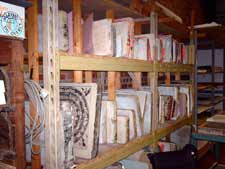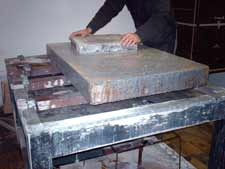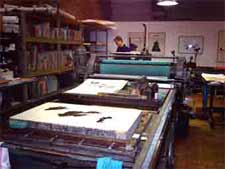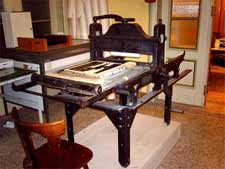WHAT IS LITHOGRAPHY
GENERALITIES
Lithography is a planographic medium. The lithograph limestones, with which the print is made, is completely flat and have a close and compact porous texture. The artist uses a greasy material to make an image on the surface of the grained lithographic stone. The surface of the lithographic stone is then treated chemically so that only the image will accept the printing ink. Both, the image and the nonprinting image areas, are situated on the same level of the stone. The technique of lithography relies on " the principle of the antipathy of grease from the oil-based ink and water on the dampened stone".
ORIGIN AND DEVELLOPEMENT
Aloïs Sennefelder, born in Praag, invented ca.1797 in München (D) after experimenting
a long time, the lithography ( lithos is Greek for stone ). He was looking for
a cheap way to print his songs, etching a stone instead of the usual method
of engraving in copper. Sennefelder found accidentally that it was possible
in certain circumstances to print a with greasy material painted limestone.
He continued his research and patented the invention of the printing technique
in Munich in 1799.
A complete account of the invention of this process is given in Sennefelder's
" Complete Course of Lithography" "Vollständiges Lehrbuch
der Steindruckerey" published in Munich ( Germany) in 1818.
THE STONE
The lithographic stone is
a kind of limestone with a very fine structure and pores. He contains micro
fragmentations of various forms of marine life. Pressure, heat and chemical
reactions compacted the calcareous deposits. It is found in Solnhofen in Bavaria
(Germany)) but is also to find in France Jura. Also Canada exports good lithographic
stone. The blue stones are hard and have a very fine structure. They are used
for delicate work. The stone must be completely flat and is mostly well grained.
After the lithographic stone is used, the old image must be carefully removed.
THE DRAWING MATERIAL
The basic materials used in making an image are very important and decisive in the process to become the desired image and must be capable to make marks that are both greasy and visible. The greasiness must be in proportion to the apparent tone or value of the mark to become black and gray (halftones). It is possible to buy all kinds of fat contents and forms. The most usual drawing materials are: litho crayons, pencils and pasta. All these materials are, whether liquid, pasta or solid, contain grease and an emulsifying agent that permits them to be diluted with water and solvents. It is also possible to transfer images on stone, drawing with litho crayon or pencil, or painting with tusche on paper or other porters. The porter play only a second role. The drawing can be transferred on stone by means of litho crayon or pencil on treated paper, also coated paper or untreated or uncoated paper. It is also possible to transfer on stone, drawings on transparent or copies from books or newspaper.
PREPARING THE STONE
Processing the drawing to prepare it for printing is one of the critical phases of lithography.The aim of processing is to separate chemically the image and the nonimage areas of the drawing so that they will receive or reject ink consistently. The stone must be stable during the printing process and the image must be taken ink in all the values of tones. To etch the stone, the lithographer uses most of all nitric acid and gum arabic. The preparation of the stone must be done carefully and professionally. Knowledge and experience are a must otherwise a part of the image is disappeared, the stone takes too much ink and all the values of halftones of the printed image are not found. After preparing the stone, it must rest during minimum 6 hours to stabilize image and drawing as well as chemically and physically.
PRINTING THE STONE
The printing of the image on the stone happens on special printing
presses: the classic lithographic hand press and the lithographic offset
press. After some preparations like such as washing out of the stone with turpentine,
the stone is completely damped with water and inked with the ink roller. The
ink, use for this process, has the same component parts as other oil based inks
anyway the choice of inks for proofing and for printing depends on experience,
on the nature of the work to be printed and on the kind of press used to print.
It's necessary to make some proofs. During this proofing process is it possible
to modify the viscosity of the ink and to correct the image by adding and removing.
Finally, the image on the stone is printed on a lithographic paper. Paper is
the supporting ground and it presences a part of the finishing work. The viscous
ink needs a good absorbing paper with a strong surface. If the lithographic
paper is too soft, fibers are lifted from the paper and are pulled in the printing
surface. This phenomenon, named picking ( lifting of fibers from the paper ),
damages the print and pollutes the image on the stone.
With thanks to Rudolf Broulim, lithographer, for providing the needful documentation.




